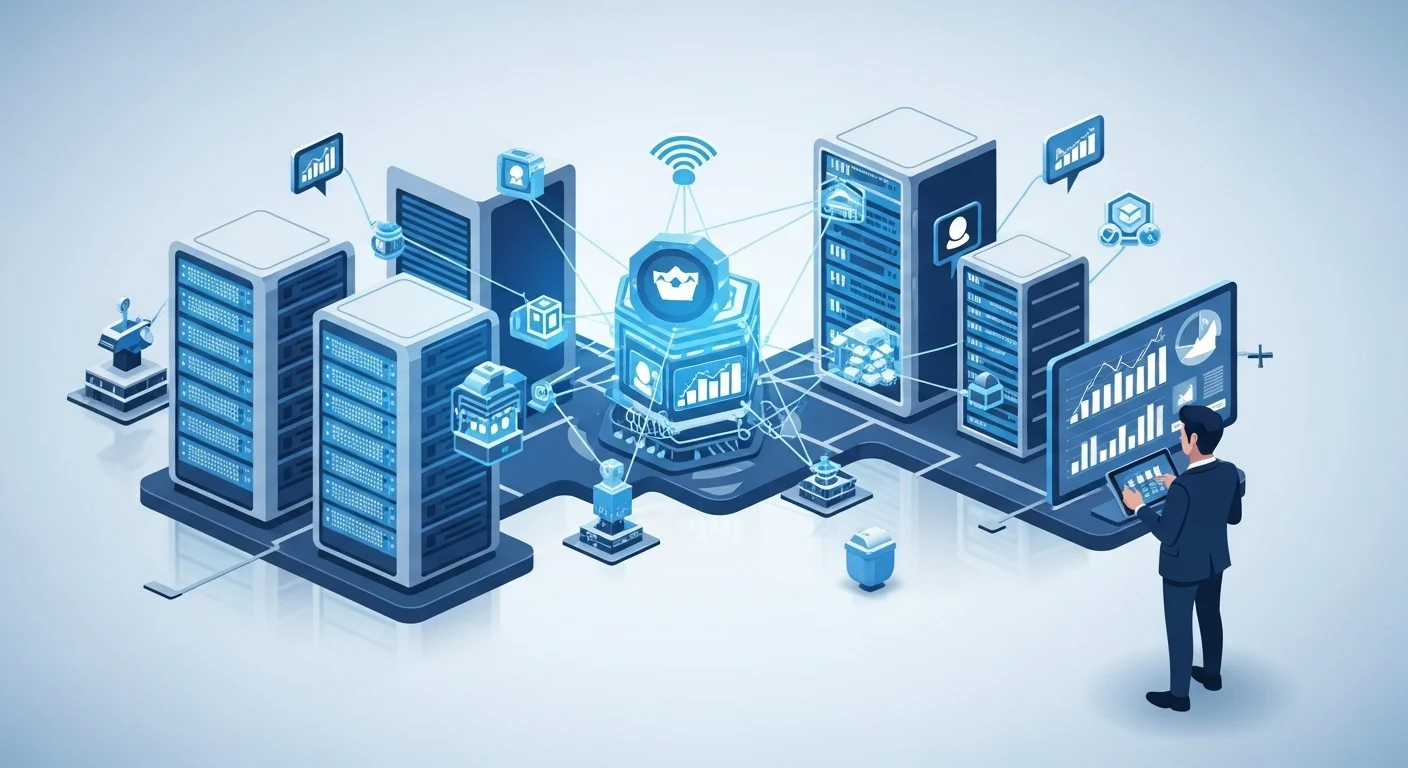Smart Automation Explained: A Practical Guide for Your Business and Home

Executive Summary
I'll never forget the first time I set up a truly 'smart' routine in my home. It wasn't just about a light turning on at a set time; it was about the house anticipating my needs. The lights faded on gently before my alarm, the coffee maker started brewing, and the thermostat adjusted to the perfect temperature. That's the magic of smart automation. It's more than just remote control; it's technology that learns, adapts, and works for you. Whether you're a business owner drowning in repetitive tasks or a tech enthusiast dreaming of a futuristic home, you're in the right place. I've spent years in this field, and I've seen how smart automation can transform efficiency and everyday life. This article is my personal guide to demystifying the buzzwords. We'll explore what this technology really is, how you can apply it in your own world, and the practical strategies I've learned for making it work seamlessly.
Table of Contents
Table of Contents
- What is Smart Automation, Really?
- A Practical Guide to Smart Automation
- Tips and Strategies I've Learned Along the Way
What is Smart Automation, Really?
Let's be honest, the term 'smart automation' gets thrown around a lot. At its heart, it's the difference between a simple, programmed instruction and an intelligent, adaptive system. Think of it this way: traditional automation is like a light switch on a timer—it turns on at 7 PM and off at 11 PM, no matter what. Smart automation is like a lighting system that knows when you enter the room, learns your daily patterns, and adjusts the brightness based on the natural light coming through the window. It’s the evolution from just 'doing' to 'thinking and doing'. This leap is made possible by combining classic automation with powerful tools like artificial intelligence (AI), machine learning (ML), and the Internet of Things (IoT). These technologies work together to analyze data, spot patterns, and make decisions without constant human input. This isn't just a futuristic concept; it's actively reshaping how businesses operate and how we live our lives, moving from simple task-doing on a factory floor to becoming the strategic brain of an organization.
For most of us, the most familiar example is the smart home. A decade ago, this was a niche hobby. Today, it’s about creating a living space that feels truly connected and responsive. This is where the idea of an intelligent, automated home comes to life. It’s not about juggling ten different apps to control ten devices. It's about creating seamless experiences. For instance, your security system uses facial recognition to tell the difference between a family member arriving and a delivery person, sending you a specific, useful notification. Your thermostat learns your comfort preferences and checks the weather forecast to save energy without you feeling a thing. This is all possible because of smart home platforms like Apple HomeKit, Google Home, or Samsung's SmartThings, which act as the central coordinator for all your devices. They use cloud-based AI to make sense of all the data from your sensors, allowing devices from different brands to work together in harmony. This is the core of modern home automation—it’s not just about programming, it's about creating an intelligent environment.
The same principles that make a home feel intuitive are revolutionizing the business world on a massive scale. In manufacturing, we call it 'Industry 4.0'. Imagine a factory where sensors on machines can predict a failure before it happens, automatically scheduling maintenance during a planned break to avoid a costly shutdown. In logistics, I’ve seen AI algorithms reroute entire fleets of delivery trucks in real time to avoid a single traffic jam, saving thousands in fuel and time. E-commerce warehouses use armies of robots to pick and pack orders with a speed and accuracy that's simply superhuman. The benefits are clear and measurable: lower costs, higher productivity, and better quality. But it goes beyond physical tasks. In finance, AI-powered automation can spot fraudulent transactions in a sea of data that a human could never sift through. It can process a loan application in minutes, not weeks. Just like the devices in a smart home, these business systems depend on a constant stream of data and intelligent analysis to deliver their value.
And we can't talk about this without touching on cybersecurity. As our digital world gets more connected, our vulnerability to attack grows. Trying to manually defend a modern corporate network is like trying to catch raindrops in a thimble. This is where smart security automation, often called SOAR (Security Orchestration, Automation, and Response), becomes essential. These platforms can automatically detect a threat, figure out if it's real, and launch a response to contain it in seconds, not hours. This is crucial for stopping things like ransomware before they can do real damage. The parallel to a smart home is perfect: just as your smart camera decides when an alert is important, a smart business security system intelligently identifies and neutralizes threats, letting human experts focus on the bigger picture. The goal is the same in both worlds: to create a resilient, self-defending, and intelligent system that adapts to its environment, whether that's your living room or a global enterprise network.

A Practical Guide to Smart Automation
So, you're ready to bring smart automation into your business or home. Where do you start? It can feel overwhelming, but I've found it helps to break it down into a few key layers, like building a house. First, you have the foundation: the Internet of Things (IoT). These are your sensors and physical devices—the smart thermostat in your hall, the motion sensor in your office, or the vibration monitor on a factory machine. They are the eyes and ears of your system. Next comes the wiring: the connectivity layer. This is your Wi-Fi, 5G, Bluetooth, and specialized protocols like Zigbee or Z-Wave. Their job is to make sure all the data from your IoT devices gets where it needs to go, reliably and quickly. In the smart home world, a new protocol called Matter is a game-changer here, aiming to get all our devices speaking the same language.
The next layer is the brain of the operation: data processing and analytics. This usually lives in the cloud on platforms like AWS, Microsoft Azure, or Google Cloud. They provide the raw computing power to handle massive amounts of data and, more importantly, the AI and machine learning tools to make sense of it all. This is where the 'smart' really happens. Data from factory sensors is analyzed to predict maintenance needs; customer emails are scanned to gauge sentiment. Finally, you have the controls: the application and orchestration layer. In business, this might be Robotic Process Automation (RPA) software that tells a 'bot' to copy data from a spreadsheet to an invoicing system. For your home, this is the app on your phone, like Apple HomeKit, Amazon Alexa, or Samsung SmartThings. This is where you build the rules and routines—the 'programming'—that tell your system what to do. For example, creating a 'Movie Night' scene that dims the lights, lowers the blinds, and turns on the TV with a single voice command.
For any business, my first piece of advice is always this: don't try to automate everything at once. I've seen that movie, and it doesn't end well. Start with a clear strategy. Identify the tasks that are repetitive, rule-based, and frankly, a bit soul-crushing for your team. These are your prime candidates. Map out the process and build a business case. What's the real return on investment (ROI)? Think beyond just saving on labor—consider the value of fewer errors, faster service, and freeing up your talented employees to solve real problems instead of copying and pasting data. I'm a huge advocate for starting with a small pilot project. Prove the concept, show the value, and then scale up. This 'start small, scale fast' approach builds momentum and minimizes risk. And please, don't forget the human side of this. Communicate openly with your team. The goal is to make their jobs better, not to replace them. Invest in training to help them manage the new automated systems and handle the complex exceptions that a bot can't.
When it's time to choose your tools, the options can be dizzying. In the business world, you'll be comparing RPA vendors on things like scalability, security, and how smart their AI really is. In the smart home space, you're choosing an ecosystem. From my experience, it often breaks down like this: Amazon's Alexa has the most compatible gadgets. Apple's HomeKit is the champion of privacy and security, doing more processing locally on your devices. Google's Assistant is fantastic at understanding natural conversation. And Samsung's SmartThings has always been a favorite for DIYers like me because of its flexibility with different protocols. For the truly adventurous, open-source platforms like Home Assistant offer ultimate control, but be prepared to roll up your sleeves and invest some time. Whether you're choosing a system for a multinational corporation or your two-bedroom apartment, the goal is the same: find the right tools to create an intelligent experience that adds real value to your life or business.

Tips and Strategies I've Learned Along the Way
After years of setting up these systems, I've collected a few hard-won lessons. Whether you're building a fully automated smart home or redesigning a business workflow, these strategies will help you get the most out of your investment. First and foremost, make security and privacy your top priority from day one. This is non-negotiable. Every smart device you add is a new potential door into your home or business network. Are you leaving it unlocked with the factory-default password? For your home, that means using strong, unique passwords for everything, enabling two-factor authentication, and being mindful of the permissions you grant to apps. For a business, it means adopting a 'zero-trust' security model. Basically, trust no one and nothing on your network by default. Regular security audits are a must. The convenience of automation should never cost you your security.
My second core strategy is to always keep a 'human in the loop'. While it's tempting to try and fully automate a process, the most resilient and effective systems I've ever built are ones that blend machine efficiency with human judgment. In a business, let the bots handle 90% of the work—the repetitive, high-volume stuff. But design the workflow so that any anomaly, exception, or complex case gets automatically escalated to a person. This leverages the best of both worlds: the speed of automation and the creativity and critical thinking of your team. In your home, this principle is just as important. It means designing automations that help you but don't control you. You should always have a simple, intuitive way to manually override a system. The goal is to create a seamless experience that serves you, not a rigid digital prison where you can't just flip a light switch.
To truly get good at this, you have to embrace continuous learning. This technology moves incredibly fast. What feels like cutting-edge today will be standard tomorrow. If you're in business, this means creating a culture where your team is encouraged to experiment and learn. Keep an eye on emerging trends like hyperautomation and AIOps (using AI to manage IT). For home tech enthusiasts, the best resource is the community. I've learned more from tech blogs, YouTube channels, and online forums than from any product manual. Communities around platforms like SmartThings or Home Assistant are filled with brilliant people sharing custom code and clever solutions that can push your system's capabilities far beyond its out-of-the-box settings. This shared knowledge is priceless.
Finally, make sure you're using the right tools for the job. Modern business software is packed with smart capabilities. CRM platforms like Salesforce use AI to predict which sales leads are most promising. Cybersecurity tools like CrowdStrike use AI to stop threats automatically. Investing in these can give you a massive leg up. For the smart home builder, choosing the right central hub is the most critical decision you'll make. While the big names—Amazon, Google, Apple—are great starting points, power users often graduate to dedicated hubs like Hubitat or the open-source Home Assistant. These offer far more powerful and flexible automation engines, letting you create truly complex routines for a responsive home. A great external resource for anyone wanting to understand the bigger picture of technology's role in our world is the MIT Technology Review, which offers incredible insight. Ultimately, mastering smart automation is a journey. By starting with a clear plan, focusing on security, keeping people at the center, and never stopping learning, you can unlock the incredible power of this technology.
Expert Reviews & Testimonials
Sarah Johnson, Business Owner ⭐⭐⭐⭐
As a small business owner, I was looking for concrete first steps. This guide helped me identify two processes in my office that are perfect for automation. A bit more on budget-friendly tools for SMEs would have made it perfect.
Mike Chen, IT Consultant ⭐⭐⭐⭐⭐
Solid overview. As an IT consultant, I appreciated the breakdown of the major platforms. The 'human-in-the-loop' philosophy is a point I constantly stress with clients, so I'm glad it was highlighted here.
Emma Davis, Tech Enthusiast ⭐⭐⭐⭐⭐
Finally, an article that connects the dots between enterprise-level automation and the smart home hobby. Alex's personal take makes the complex concepts easy to grasp. This is a bookmark-worthy resource.



